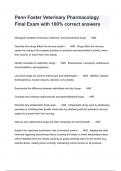Penn
Foster
Veterinary
Pharmacology
Final
Exam
with
100%
correct
answers
Distinguish
between
hormonal,
endocrine,
and
reproductive
drugs
-
ANS
Describe
how
drugs
affect
the
nervous
system
-
ANS
Drugs
affect
the
nervous
system
by
acting
at
the
synaptic
junctions
to
promote
neurotransmitter's
activity,
mimic
their
actions,
or
block
them
from
acting.
Identify
examples
of
respiratory
drugs
-
ANS
Expectorants,
mucolytics,
antitussives,
bronchodilators,
decongestants
List
which
drugs
are
used
to
relieve
pain
and
inflammation
-
ANS
NSAIDs,
Opioids,
Antihistamines,
muscle
relaxers,
steroids,
nerve
blocks
Summarize
the
difference
between
ophthalmic
and
otic
drugs
-
ANS
Compare
and
contrast
cardiovascular
and
gastrointestinal
drugs
-
ANS
Describe
how
antiparasitic
drugs
work
-
ANS
Antiparasitic
drugs
work
by
destroying
parasites
or
inhibiting
their
growth.
Most
work
by
interfering
with
the
parasite's
nervous
system
to
prevent
them
from
moving.
Discuss
why
replacement
drugs
are
often
necessary
for
animal
health
-
ANS
Explain
the
veterinary
technician's
role
in
inventory
control
-
ANS
keeping
the
staff
informed
regarding
discontinued
items,
knowing
the
dates
on
which
backordered
items
will
be
released
from
the
vendor,
packing
up
goods
awaiting
return
to
the
vendor
(e.g.,
expired
items),
rotating
stock
correctly,
maintaining
current
prices
on
all
products, organizing
inventory
for
ease
of
location
and
counting,
receiving
and
inspecting
orders
on
arrival
at
the
veterinary
facility,
and
learning
about
new
products.
Define:
Agonist
-
ANS
Drug
that
has
affinity
for
a
receptor/stimulates
receptor
into
action
Define:
Contraindication
-
ANS
A
reason
not
to
use
a
drug
in
a
particular
situation
Define:
Efficacy
-
ANS
the
degree
to
which
a
drug
produces
its
desired
response.
Define:
Over-the-counter
drug
-
ANS
One
that
may
be
purchased
without
prescription
from
a
veterinarian
Define:
Prescription
Drug
-
ANS
One
that
must
be
used
under
the
supervision
of
a
veterinarina
Define:
Receptor
-
ANS
a
group
of
specialized
molecules
on
or
in
a
cell
that
bind
with
a
drug
to
produce
an
effect
Define:
Therapeutic
Index
-
ANS
expresses
the
relationship
between
a
drug's
therapeutic
and
harmful
effects
Define:
Withdrawl
Time
-
ANS
Amount
of
time
that
must
elapse
between
the
end
of
drug
therapy
and
elimination
of
that
drug
from
patients
tissues
or
products
Define:
Veterinarian-client-patient
relationship
-
ANS
Relationship
that
must
exist
between
the
vet,
the
patient,
and
the
owner
before
prescription
drugs
can
be
dispensed.
List
4
sources
of
drugs
used
in
Vet
Med
-
ANS
Animal
product,
plant
material,
minerals,
synthetic
products What
are
4
components
of
a
drug
regimen?
-
ANS
Dose,
route,
frequency,
and
duration
of
administration.
Discuss
the
conditions
that
must
be
met
before
a
valid
veterinarian-client-patient
relationship
can
be
shown
to
exist
-
ANS
1.vet
must
assume
responsibility
for
making
clinical
judgments
in
relation
to
health
of
the
animal.
2.
Vet
must
have
recently
seen
the
animal
and
be
acquainted
with
it's
care.
3.Vet
must
be
available
for
follow-up
care
of
the
animal
Discuss
the
responsibilities
of
a
vet
tech
in
the
administration
of
drug
orders
-
ANS
To
carry
out
the
vet's
orders
correctly.
should
read
the
drug
label
three
times
to
ensure
proper
drug
is
being
administered
and
should
take
care
to
administer
correct
dose
by
correct
route.
Should
be
aware
of
the
expected
affects
and
potential
adverse
side
effects
and
be
able
to
monitor
the
patient.
Describe
the
sequence
of
events
that
a
drug
undergoes
from
administration
to
excretion
-
ANS
Drug
is
absorbed
(or
placed
directly)
into
the
bloodstream,
the
drug
may
bind
with
plasma
in
the
blood
or
may
exist
in
free
state,
circulating
blood
distributes
drug
to
capillary
level
where
it
leaves
circulation
and
enters
interstitial
fluid.
it
bathes
the
cell
and
allows
drug
to
bind
to
cell
surface
receptors
or
enter
the
cell.
It
then
exits
the
cell
and
moves
back
into
interstitial
fluid,
reenters
circulation,
and
is
transported
to
liver
for
metabolism.
The
metabolite
is
then
transported
to
kidneys
for
excretion.
List
11
possible
routes
for
administering
a
drug
to
a
patient.
-
ANS
Oral,
subcutaneous,
intramuscular ,
intravenous,
intraperitoneal,
intraarterial,
intracardiac,
intramedullary ,
inhalation,
topical,
intradermal
List
some
of
the
factors
that
influence
drug
absorption
-
ANS
Method
of
absorption,
pH
of
the
drug
and
ionization
status,
absorptive
surface
area,
blood
supply
to
area,
solubility
of
drug,
dosage
form,
status
of
GI
tract,
and
interactions
with
other
drugs Most
biotransformation
occurs
in
the_____
-
ANS
Liver
Most
drug
excretion
occurs
via
the
______
-
ANS
Kidneys
Drugs
usually
produce
their
effects
by
combining
with
specific
cellular_____
-
ANS
Receptors
The
drug
name
chosen
by
the
manufacturer
and
is
exclusive
property
of
that
company
is
called
-
ANS
Trade/Proprietary
Name
What
are
the
6
items
that
must
be
included
on
drug
label?
-
ANS
names
(generic
and
trade)
concentration,
quantity,
name
and
address
of
manufacturer ,
control
or
lot
number,
expiration
date
What
are
three
government
agencies
that
regulate
the
development,
approval,
and
use
of
animal
health
products?
-
ANS
FDA,
EPA,
USDA
Why
do
many
vet
clinics
dispense
rather
than
prescribe
most
of
the
drugs
that
they
use?
-
ANS
Profit
earned
from
selling
products
Describe
the
marketing
of
animal
health
products
-
ANS
Purchased
from
manufacturers,
distributors,
or
generic
mail
order
companies.
May
be
sold
only
one
label
to
graduate
veterinarians
and
under
another
as
over-the-counter
all
FDA-approved
veterinary
drugs
are
listed
in
the
publication
entitled_____
-
ANS
The
Green
Book
What
is
the
purpose
of
FARAD?
-
ANS
Provides
resources
concerning
the
avoidance
of
drug
residues
in
animals




